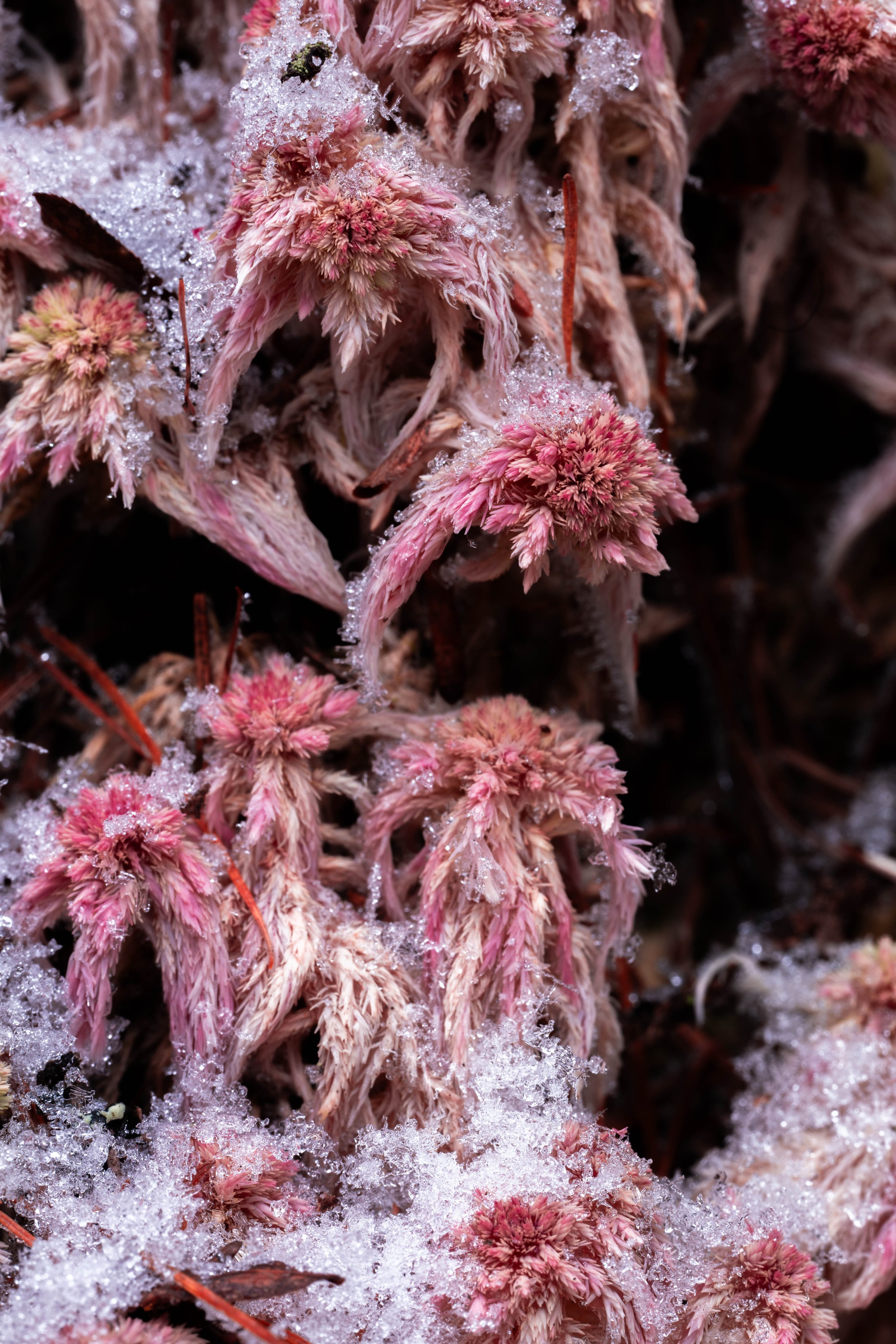Winter Survival
Winter is harsh in northern peatlands. Food is scarce, temperatures can dip into double-digit negatives for weeks on end, and daylight is limited. Many species migrate to warmer climates in the winter. A few species have adaptations that allow them to survive, and even thrive, in these harsh conditions. Here are a few of these hardy species, some of which you might be able to see if you explore a northern peatland in the winter.
Gray Jay
Gray Jays cache food throughout the summer to be able to survive frigid winter months. They make incisions in tree bark and use their sticky saliva to glue food caches beneath the bark. Their hippocampus—the part of the brain responsible for spatial memory—grows disproportionately while they are stashing and retrieving their food caches throughout the forest.
Peatlands provide the perfect habitat for these omnivorous birds, with abundant and diverse food sources.
Gray Jays are inquisitive. These northern forest birds are getting ready to lay eggs and raise chicks in the dead of winter. Their hidden food stores help them raise chicks when other birds are simply trying to survive.
In the film above, you’ll notice the Gray Jays are puffed to stay warm on a frigid winter day. At the end of the film, you will get a glimpse of the brood patch this jay will use to keep its clutch of eggs warm throughout the cold winter nights ahead.
Wood Frog
This spring, wood frogs will be the first to emerge. They have been spotted moving across snow banks in search of a vernal spawning pool, where they huddle together while making a ruckus of cackling chuckles, searching for a mate.
To survive the winter, wood frogs bury themselves in mud underwater, where they freeze. This can be a dangerous strategy. If ice crystals form within cell walls, the ice can puncture cell membranes, killing them. If enough cells in vital organs die, the creature will die.
Enter the anti-freeze strategy. Frogs and reptiles that freeze overwinter produce glucose and deliver it to their vital organs. Higher glucose concentrations help to depress the freezing point of their vital organs, preventing ice crystal formation.
Eastern Newt
These creatures have both aquatic and terrestrial life stages. They start as aquatic juveniles with gills, then become terrestrial efts with lungs. In this life stage, they are bright orange in color. Some newts will live out the rest of their lives in the eft stage, but many will return to an aquatic stage when the conditions are right.
Similar to the wood frog, these newts survive the winter by burying themselves in mud and beneath leaf litter, where they effectively freeze until spring.
Sphagnum Moss
There are more than 300 species of sphagnum moss. Each species is adapted to the unique characteristics of their particular habitat. The species growing in the northern hemisphere have adaptations that allow them to survive cold winters.
Ice formation is the great enemy of plant survival in the winter. Many plants go through what is called a “hardening” process, where they shuttle water outside cell walls so that ice does not form within vital organs. With less water inside the plant cells, the freezing point is depressed due to the higher concentration of sugars. This means it will take colder temperatures before ice can form within these areas.
Colder nights and shorter days trigger sphagnum moss to desiccate (dry out), encouraging ice to form on top of the sphagnum moss. As winter progresses, snow cover will help insulate the sphagnum from extreme cold.
The most vulnerable time for sphagnum moss (as well as other plants) is the onset of winter. Cold snaps can kill sphagnum moss before it has a chance to prepare for the cold.
Climate change is presenting a new challenge to these cold-hardy species. While hardening is a slow process, these protections unravel quickly as temperatures warm. With many rapid freeze-thaw events throughout the winter, sphagnum moss doesn’t have the time it needs to protect itself from plummeting temperatures. In addition, the blanket of snow that once protected sphagnum moss from extreme temperatures throughout the winter is now greatly reduced––or not present––in winter months.
Adirondack Park is the southernmost location where northern peatlands exist. If we study the changes as they happen here, we will be able to predict how peatlands will respond further north in the coming years. And perhaps, this knowledge will help us conserve and protect these ecosystems in the face of climate change.
For the love of peat
At a time when we are losing species faster than we can save them, peatland conservation and restoration present an opportunity to support global biodiversity. As our planet warms and severe weather events become more extreme, this ecosystem is in peril.
But it also has untapped potential. By conserving and restoring peatlands, we can address biodiversity loss, global warming, and help ensure this rare ecosystem continues to thrive on our planet.
As I write this article, The Northern Peatlands Project is an after-hours commitment at Twolined Studio. I am spending as many days as I possibly can on this work, but there is so much more that I could be doing to promote peatland conservation and restoration. I am in the process of seeking partners and sponsors so that I can dedicate more field days to help protect and conserve this ecosystem, and to raise awareness of the importance of our peatlands before it is too late.
In an effort to highlight this work, I’ve put together a short film describing what I do on The Northern Peatlands Project, and why I think others should join me on this journey.
If you would like to help, please share this film with your friends. Let’s show the world how wild and bizarre these places are, and how important they are to the survival of our one home. It’s time to grow the ranks of the Secret Society of Peatland Enthusiasts.





